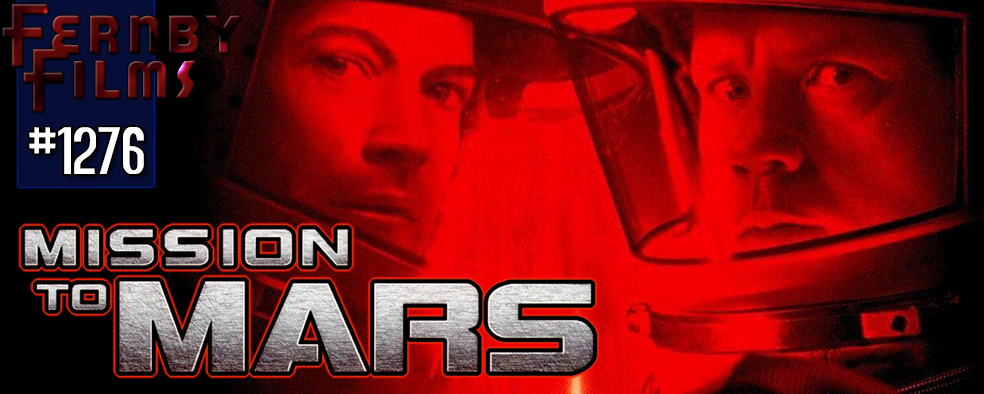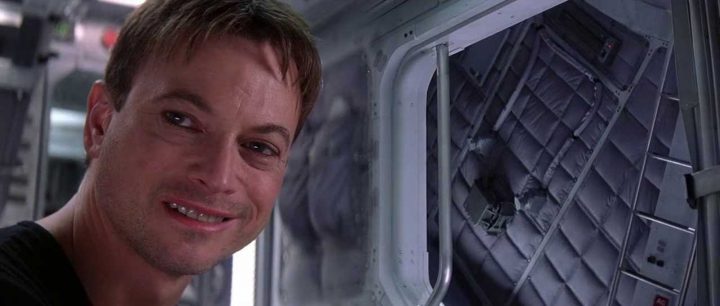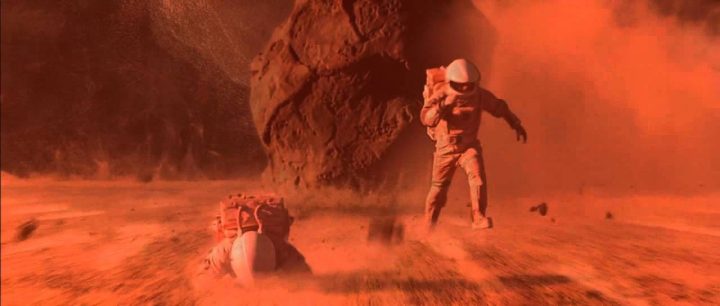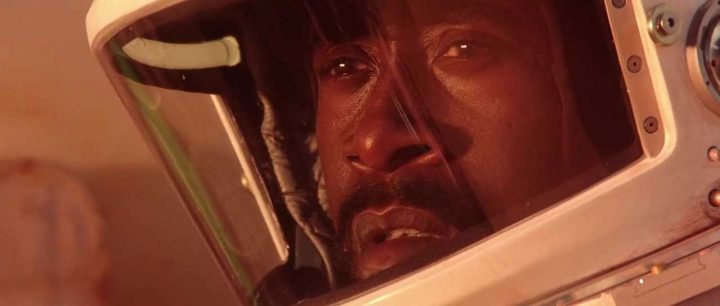Movie Review – Mission To Mars

Director : Brian DePalma
Year Of Release : 2000
Principal Cast : Gary Sinise, Tim Robbins, Don Cheadle, Connie Nielsen, Jerry O’Connell, Kim Delaney, Peter Outerbridge, Kavan Smith, Jill Teed, Armin Mueller-Stahl, Elise Neal.
Approx Running Time : 113 Minutes
Synopsis: When the first manned mission to Mars meets with a catastrophic and mysterious disaster after reporting a unidentified structure, a rescue mission is launched to investigate the tragedy and bring back any survivors.
******
By the time Mission To Mars arrived early in 2000, Brian DePalma had struck paydirt twice in recent history with the Mission: Impossible reboot, and Nic Cage’s Snake Eyes (which also saw him team up with Gary Sinise, who headlines here). While his older films never really grabbed my attention, DePalma struck me as a cinematic maverick, his long-take usage and sense of scale something new to my relatively young appreciation of the medium. Mission To Mars, marketed as a grand space thriller, marked a crucial misstep in the acclaimed director’s career, a weird Kubrickian attempt to out-2001 2001: A Space Odyssey. Instead of some giant black monolith, however, DePalma’s red planet flick finds Sinise, together with Shawshank Redemption star Tim Robbins and Gladiator’s Connie Nielsen, attempting a rescue mission to stranded astronauts on the surface of Mars.
 Sinise plays Jim McConnell, a recently bereaved NASA astronaut who looks on as his friend Luke Graham (Don Cheadle) begins the first manned mission to explore Mars’ surface. When Luke and his crew are lost to what appears to be an intelligent sandstorm on the surface, Jim, together with his own crew – Woody (Tim Robbins), Woody’s wife Terri (Connie Nielse), and flight tech Phil (Jerry O’Connell) set off on their own voyage to find out what happened.
Sinise plays Jim McConnell, a recently bereaved NASA astronaut who looks on as his friend Luke Graham (Don Cheadle) begins the first manned mission to explore Mars’ surface. When Luke and his crew are lost to what appears to be an intelligent sandstorm on the surface, Jim, together with his own crew – Woody (Tim Robbins), Woody’s wife Terri (Connie Nielse), and flight tech Phil (Jerry O’Connell) set off on their own voyage to find out what happened.
Boasting a score by none other than legendary composer Ennio Morricone (The Good, The Bad & The Ugly), and photographed by DePalma’s regular cinematographer Stephen Burum, Mission To Mars lacks nought for quality behind the camera. In front of it, DePalma works with a top-line cast as well, so one can’t fault money being spent on talented actors. So why, then, does Mission To Mars fall so flat? Perhaps it’s the film’s bothersome ponderousness, a quasi-serious philosophising on mankind’s place in the cosmos, our smallness against the backdrop of space, and a omnipresent dose of “leave no man behind” USA rah-rah heroism. Perhaps it’s DePalma’s bizarrely inert direction, which alternates between stately, comatose plotting and magnanimous pontification.
 The screenplay, credited to Jim and John Thomas and Speed scribe Graham Yost, never clicks into high gear, content to generate mystery and low-fi thrills purely because of its place, rather than anything inherent in the characters. Sinise is what one might term “the star” of the film, but the movie works better an an ensemble, which it is more often than not. Although imbuing each character with your traditional “rescue in space” cluster of disparate personalities, Mission To Mars feels blandly devised, a heavy handed exploratory euphoria covering some weird join-the-dots alien mystery than discordantly jars with ambiguity. The mystery of the film ain’t so much what “the alienz” want, but how we handle our investigation of it.
The screenplay, credited to Jim and John Thomas and Speed scribe Graham Yost, never clicks into high gear, content to generate mystery and low-fi thrills purely because of its place, rather than anything inherent in the characters. Sinise is what one might term “the star” of the film, but the movie works better an an ensemble, which it is more often than not. Although imbuing each character with your traditional “rescue in space” cluster of disparate personalities, Mission To Mars feels blandly devised, a heavy handed exploratory euphoria covering some weird join-the-dots alien mystery than discordantly jars with ambiguity. The mystery of the film ain’t so much what “the alienz” want, but how we handle our investigation of it.
I remember walking out of Mission To Mars at the cinema and thinking I’d wasted a couple of hours that I’d never get back, but in recent times I’ve thought about revisiting the movie to see if my initial response to it was warranted. In the 16 years since I saw Mission To Mars the first time, I’ve grown to appreciate cinema which makes you think (as opposed to just blowing shit up), and multiple viewings of 2001: A Space Odyssey has strengthened my resolve to re-discover films that provoke ideas and theories. I’m not comparing this film to Kubrick’s masterpiece, nor should anyone simply because it has echoes within its discovery DNA, but rather that another look into this daffy little sci-fi opus might bring with it something new that maturity allows.
 Mission To Mars’ lethargic pacing and square-jawed heroism runs counter to the brave new world of exploratory fiction on display here. Sinise musters barely a grimace (seriously, though, what the hell is happening to his face in this movie?) as he squirms through a worse role than the one he had in Apollo 13, while Tim Robbins looks like he’s having an absolute blast with what is, essentially, a cowboy-in-space role that he can do in his sleep. Connie Nielsen looks lost, Jerry O’Connell seems at least interested if criminally underwritten, and Don Cheadle’s role as this film’s Matt-Damon-On-Mars feels like a plot device brushed aside all too easily. None of the cast offer a performance that’s particularly memorable or demanding (with the exception of Cheadles, I think) but nobody steps out of line in service of the story. It’s just a shame the story is so hokey.
Mission To Mars’ lethargic pacing and square-jawed heroism runs counter to the brave new world of exploratory fiction on display here. Sinise musters barely a grimace (seriously, though, what the hell is happening to his face in this movie?) as he squirms through a worse role than the one he had in Apollo 13, while Tim Robbins looks like he’s having an absolute blast with what is, essentially, a cowboy-in-space role that he can do in his sleep. Connie Nielsen looks lost, Jerry O’Connell seems at least interested if criminally underwritten, and Don Cheadle’s role as this film’s Matt-Damon-On-Mars feels like a plot device brushed aside all too easily. None of the cast offer a performance that’s particularly memorable or demanding (with the exception of Cheadles, I think) but nobody steps out of line in service of the story. It’s just a shame the story is so hokey.
Mission To Mars feels saturated with science fiction tropes to the point where it should sink under its own gravity. It certainly offers nothing new to the genre, even going all Kingdom Of The Crystal Skull towards the end and outright explaining for the audience what the hell is going on, rather than asking the viewer to figure things out on their own. But it looks pretty, and contains a hugely active surround mix if you’re watching in HD; in spite of similarities with 2001 and DePalma’s frustrating decision to forgo tension or emotional complexity, Mission To Mars fails to work either as an intelligent dramatic exploration of humanity or as a sci-fi spectacle offering better-than-average visual effects.





